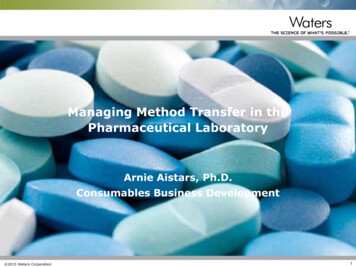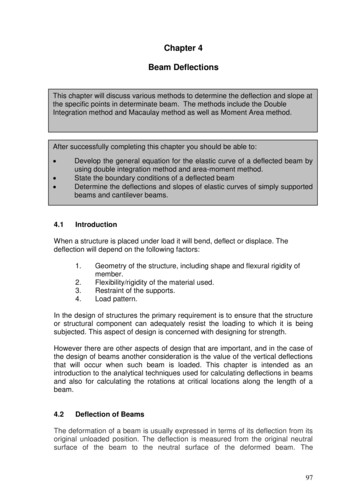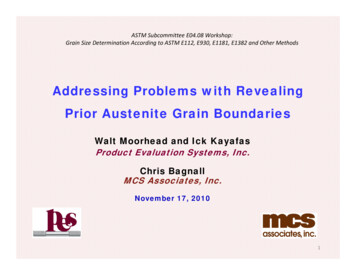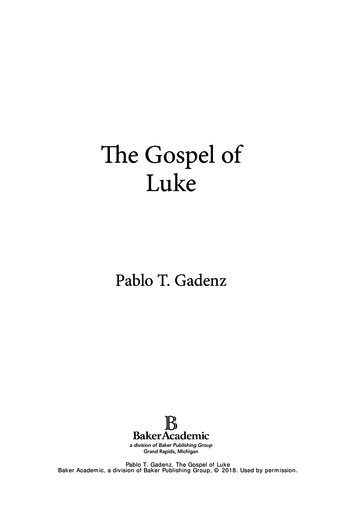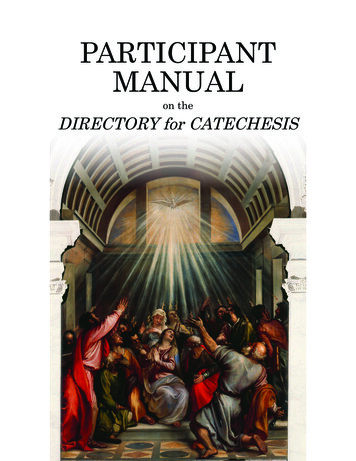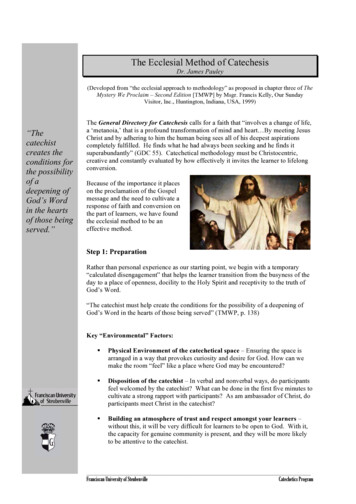
Transcription
The Ecclesial Method of CatechesisDr. James Pauley(Developed from “the ecclesial approach to methodology” as proposed in chapter three of TheMystery We Proclaim – Second Edition [TMWP] by Msgr. Francis Kelly, Our SundayVisitor, Inc., Huntington, Indiana, USA, 1999)“Thecatechistcreates theconditions forthe possibilityof adeepening ofGod’s Wordin the heartsof those beingserved.”The General Directory for Catechesis calls for a faith that “involves a change of life,a ‘metanoia,’ that is a profound transformation of mind and heart By meeting JesusChrist and by adhering to him the human being sees all of his deepest aspirationscompletely fulfilled. He finds what he had always been seeking and he finds itsuperabundantly” (GDC 55). Catechetical methodology must be Christocentric,creative and constantly evaluated by how effectively it invites the learner to lifelongconversion.Because of the importance it placeson the proclamation of the Gospelmessage and the need to cultivate aresponse of faith and conversion onthe part of learners, we have foundthe ecclesial method to be aneffective method.Step 1: PreparationRather than personal experience as our starting point, we begin with a temporary“calculated disengagement” that helps the learner transition from the busyness of theday to a place of openness, docility to the Holy Spirit and receptivity to the truth ofGod’s Word.“The catechist must help create the conditions for the possibility of a deepening ofGod’s Word in the hearts of those being served” (TMWP, p. 138)Key “Environmental” Factors:§Physical Environment of the catechetical space – Ensuring the space isarranged in a way that provokes curiosity and desire for God. How can wemake the room “feel” like a place where God may be encountered?§Disposition of the catechist – In verbal and nonverbal ways, do participantsfeel welcomed by the catechist? What can be done in the first five minutes tocultivate a strong rapport with participants? As am ambassador of Christ, doparticipants meet Christ in the catechist?§Building an atmosphere of trust and respect amongst your learners –without this, it will be very difficult for learners to be open to God. With it,the capacity for genuine community is present, and they will be more likelyto be attentive to the catechist.Franciscan University of SteubenvilleCatechetics Program
Prayer – the “high point” of the preparation step: Catechesis beginning “in thename of the Father and of the Son and of the Holy Spirit ”§The catechist’s welcome and interaction with participants as well as anyopening activities and discussion purposes to gain participants’ attention andprepare them for an encounter with God through catechesis. This step drawsto a close with a time where genuine prayer is the objective.§An experience of prayerful encounter is the final and climactic phase of thepreparation step. Beginning with an opportunity for prayerful communionwith God is necessary in inviting participants to a place of openness andanticipation of what will be communicated in the “proclamation.”§The catechist mentors participants in the life of prayer. Catechetical prayernot only prepares them for the present time of catechesis, but also is anopportunity to form their lifelong ability for prayer. Therefore, catecheticalprayer draws them to deeper confidence in praying with Scripture, with theliturgy, with music, with silence, with formal prayers, with spontaneousprayer, with Christian prayers from various cultures, with the prayers of thesaints, and with prayer that arises in their own hearts. Gradually,incrementally, the catechist guides each learner to be comfortable with theimmense diversity of the life of Catholic prayer.The primary objective of this step: to help participants be focused, curious, and in aplace of desire for God.Step 2: Proclamation§Central step of the method.§This is the joyful, convicted announcement of the Good News. In one or twosentences, how can the heart of the content of the catechesis be expressed in away that the learner will understand it and situate everything else they learnaround this central statement?§A good proclamation is§oGod-focused – comes from/leads to God in ChristoInteresting!!! [Age- and group-appropriateoShort, concise, easy to remember – it will be the one thing “ringingin their ears” as they leave the catechetical setting.§ Therefore, it must be verbally and visually reinforcedoInternalized and understood so well by the catechist, that it is notread but proclaimed from the heart with confidence and joyEffective proclamations can be found or created by the catechist. Someplaces to search for proclamations include: the Bible [a primary source!], theCatechism, the liturgy, a textbook, the insights of the saints and contemporaryChristian witnesses, and, on occasion, even from various cultural sources[movies, music, books, etc.]. Proclamations can also be adapted or createdFranciscan University of SteubenvilleCatechetics Program“The catechistmentorsparticipants inthe life ofprayer Gradually,incrementally,the catechistguides eachlearner to becomfortablewith theimmensediversity of thelife of prayer.”
by the catechist. No matter how a proclamation is formulated, this steppresupposes on the part of the catechist a thorough grasp of the doctrine andits implications in the Christian life§“Firm andwell-thoughtoutconvictionslead tocourageousand uprightaction”(John Paul II,CatechesiTradendae22)Some examples of proclamations include:o“For God so loved the world that he gave his only Son, so thateveryone who believes in him might not perish but might haveeternal life” (John 3:16)oBehold, behold, the wood of the cross, on which is hung oursalvation. O come, let us adore!oThe Eucharist is the source and summit of the Christian life – it isthrough the Eucharist that we are all united in Christ.oLent is a springtime for our souls if we surrender to Christ theGardener [from a former student]!oGod’s greatest attribute is His mercy!oChrist came to pay a debt He didn’t owe because we owed a debt wecouldn’t pay!oSunday is the day the Lord has made; we must be glad and rejoice!(based on Ps118:24)oGod is real and He has left traces of Himself all over creation so thatwe can come to know and love Him!oChrist became poor so that you may become rich!Step 3: Explanation“In the third step, in a certain sense, the catechist’s personal creativity is now morechallenged and evoked so that they may help participants come to a deeper personalunderstanding and assimilation of the message of faith. The explanation that will bemade will, of course, be always in the light of the Church’s understanding of theWord, but the catechist is challenged to find appropriate ways to ‘inculturate’ thismessage so that it can be adapted to diverse groups to whom it is addressed. This willbe done by utilizing appropriate pedagogical and andragogical teaching/learningtechniques and by tapping into cultural points of reference that can help with theunderstanding of the message” (TMWP, p. 143).Characteristics of this step:§Most likely the longest step in the method. Time and creativity need to beput into this step so that the learners truly can understand the meaning ofwhat has been proclaimed.§Active participation on part of learner is particularly important. This steprequires “the active engagement of the participants, so that the relevance ofthe Word to their life story and to contemporary issues can be brought toFranciscan University of SteubenvilleCatechetics Program
light” (TMWP, p. 143). The challenge facing the catechist in this steprevolves around how to best intellectually engage participants, to facilitateactive learning.§Both inductive and deductive learning processes involved – Apologeticsand fruitful use of memorization should beused along with storytelling, question andanswer, dialog between catechist andlearners, roleplaying, art, music, literature,appropriate connections to humanexperience.§Learning styles and variety of multipleintelligences of learners engaged so as toelicit a full response of faith§Frequent reinforcement of theproclamation is important, demonstratinghow a clearer understanding of the contentin this step helps the proclamation to betaken in.The primary objective: to arrive at a deeper understanding by way of activelearning.Step 4: Application“Firm and well-thought-out convictions lead to courageous and upright action” (JohnPaul II, Catechesi Tradendae 22)The Deposit of Faith is not meant to be merely intellectualized – its delivery is meantto lead to a full response of faith, to the transformation of the individual and society.Christian conversion of heart and mind does not happen without asking the question“what are we to do?” (Acts 2:37)How does this catechesis apply within a cultural and personal context?Relevance to six key areas of the Christian life could be explored whencultivating personal application [see the GDC 87’s “six tasks of catechesis”]:§Appropriation and Acceptance of the Christian Faith – How are thesetruths either promoted or undermined within various cultural contexts? Whatdo these truths mean for my personal understanding of God, of faith?§The Moral Life – How are various moral emphases within the cultureconsistent or inconsistent with the particular aspect of the Christianworldview understood today? How does the Christian understanding underdiscussion impact the personal moral decision-making process?§Liturgical Participation – How are these truths highlighted and celebratedliturgically? How does this doctrinal understanding impact how we approachGod in liturgical prayer?Franciscan University of SteubenvilleCatechetics Program“It is crucialto create theopportunitiesfor Christianconversion inthecatecheticalsetting andencourageopportunitiesfor thisconversion tocontinue inthe life of thefamily.”
§Encounter with God in Prayer – How does this new understanding enhancethe depth of communion possible in personal prayer? How might thesedoctrinal truths help us to pray in a more genuine, filial way?§Participation in Community Life – How are we called to give ourselves inpresence to service of others? Within the Catholic community? In variouscommunities outside of the Catholic communion?§Awareness and Participation in Missionary Vocation – How does thisunderstanding advance our living out of our vocations as evangelists, youngpeople, married couples, etc.? How can we be better equipped to givewitness to and articulate these truths for others?Many are the ways this step can be done: carefully led small group discussion, atime of silence/meditation, journaling, prayer with others, analysis of some culturalexpression [filmclip, music, event description, op-ed piece, etc.], opportunities forspecific resolutions for growth in holiness, etc.In the end, what is hoped for is (1) a life of increasing personal Christian holiness andwitness and (2) life orientation of deeper service to others“Our mission is to bring the faith to today’s real world. This means being sensitive tothe modern world’s concerns and also seeking to understand critically its thoughtpatterns and language. It must be, however, our humble conviction that we have thevalues and truth that this modern world is actually seeking” (TMWP, p.63).“We look atthe‘wonderfulthings’ Godhas done inthe CreationandRedemptionand arespontaneously impelled toprayer andpraise.”The primary objective: to create opportunities for our learners to choose tointegrate faith and life.Step 5: Celebration“If the catechetical process begins in prayerful attentiveness and openness to theWord of God, I believe that it must also end in prayerful gratitude and praise to God.This attitude of thanksgiving and praise is paradigmatic for all of Christian life. Welook at the ‘wonderful things’ God has done in the Creation and Redemption and areFranciscan University of SteubenvilleCatechetics Program
spontaneously impelled to prayer and praise. This must be a major part and theclimax of a catechetical process and methodology that is deeply rooted in theChurch’s own faith and self-understanding” (TMWP, p. 146-147).This final step:§Cultivates a spirit of praise and gratitude in the presence of God’s Word,the evangelii gaudium.§Ends in a place of thanksgiving and not criticism, skepticism, confusion.The aim is for the learner to leave the catechetical setting in place of peaceand joy and preparedness for life’s challenges§To accomplish this, the catechist may choose at times explicitly to bringlearners to a place of thanksgiving (for example, “the Eucharist, body andblood, soul and divinity of Christ is such a gift to us – let’s turn to the Lord inprayer and thank him now for this immense grace in our lives ”)§The catechist may choose to creatively incorporate the session proclamationinto prayer, bringing focus of catechesis back to the heart of the doctrinefocused on§Ideas to incorporate into prayer during celebration step:oLiturgy of Word, liturgy of hours, a focus on liturgical yearoMusic – listening or singingoPrayers of gratitude and praiseoReflective use of symbols – cross, candle, image of Blessed VirginoPerhaps moving into the church to pray or inviting learners to comeup individually to receive prayers of groupNotes/Questions/Insights:Franciscan University of SteubenvilleCatechetics Program
Mystery We Proclaim – Second Edition [TMWP] by Msgr. Francis Kelly, Our Sunday Visitor, Inc., Huntington, Indiana, USA, 1999) The General Directory for Catechesis calls for a faith that “involves a change of l


